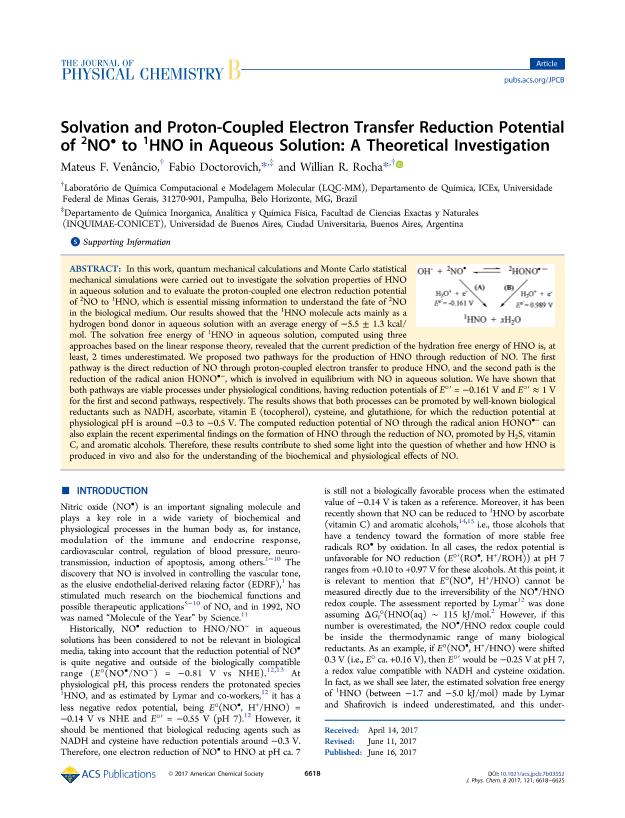Artículo
Solvation and Proton-Coupled Electron Transfer Reduction Potential of 2NO• to 1HNO in Aqueous Solution: A Theoretical Investigation
Fecha de publicación:
07/2017
Editorial:
American Chemical Society
Revista:
Journal of Physical Chemistry B
ISSN:
1520-6106
Idioma:
Inglés
Tipo de recurso:
Artículo publicado
Clasificación temática:
Resumen
In this work, quantum mechanical calculations and Monte Carlo statistical mechanical simulations were carried out to investigate the solvation properties of HNO in aqueous solution and to evaluate the proton-coupled one electron reduction potential of 2NO to 1HNO, which is essential missing information to understand the fate of 2NO in the biological medium. Our results showed that the 1HNO molecule acts mainly as a hydrogen bond donor in aqueous solution with an average energy of -5.5 ± 1.3 kcal/mol. The solvation free energy of 1HNO in aqueous solution, computed using three approaches based on the linear response theory, revealed that the current prediction of the hydration free energy of HNO is, at least, 2 times underestimated. We proposed two pathways for the production of HNO through reduction of NO. The first pathway is the direct reduction of NO through proton-coupled electron transfer to produce HNO, and the second path is the reduction of the radical anion HONO•-, which is involved in equilibrium with NO in aqueous solution. We have shown that both pathways are viable processes under physiological conditions, having reduction potentials of E°′ = -0.161 V and E°′ ≈ 1 V for the first and second pathways, respectively. The results shows that both processes can be promoted by well-known biological reductants such as NADH, ascorbate, vitamin E (tocopherol), cysteine, and glutathione, for which the reduction potential at physiological pH is around -0.3 to -0.5 V. The computed reduction potential of NO through the radical anion HONO•- can also explain the recent experimental findings on the formation of HNO through the reduction of NO, promoted by H2S, vitamin C, and aromatic alcohols. Therefore, these results contribute to shed some light into the question of whether and how HNO is produced in vivo and also for the understanding of the biochemical and physiological effects of NO.
Palabras clave:
Reduction
,
Potential
,
Hno
,
Calculation
Archivos asociados
Licencia
Identificadores
Colecciones
Articulos(INQUIMAE)
Articulos de INST.D/QUIM FIS D/L MATERIALES MEDIOAMB Y ENERGIA
Articulos de INST.D/QUIM FIS D/L MATERIALES MEDIOAMB Y ENERGIA
Citación
Venâncio, Mateus F.; Doctorovich, Fabio; Rocha, Willian R.; Solvation and Proton-Coupled Electron Transfer Reduction Potential of 2NO• to 1HNO in Aqueous Solution: A Theoretical Investigation; American Chemical Society; Journal of Physical Chemistry B; 121; 27; 7-2017; 6618-6625
Compartir
Altmétricas




